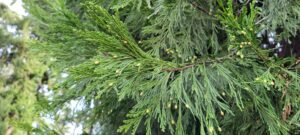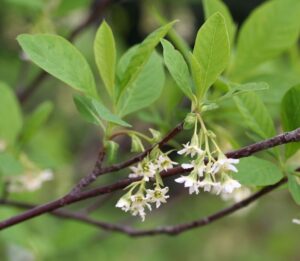Tag: pollen
Spring is coming! Or is it already here?
The Eugene Team shares their favorite signs of springtime
“Many buds are starting to swell,” Erik Burke says when asked when spring will arrive. “Witch-hazel, Persian ironwood and osoberry are all insect-pollinated woody plants that are blooming. Spring is here.”
The Eugene Director has always noted that the seasons aren’t evenly distributed in Western Oregon and Southwest Washington. “We have a short autumn, a relatively short winter, and long springs and summers. November is our wettest month on average, January is our coldest month, and while February can be cold, spring typically begins early in the month.”
Meteorologists observe March 1st as the first day of spring. Our calendars say March 19, the vernal equinox, when the days finally begin to be longer than the nights. But plants are on their own schedule.

“It’s a gradual roll out,” Erik says. We’ll see camas come out of the ground in December or early January as the incense cedar starts blooming. Filberts pollinate in January, and in February, we’re seeing willows leafing out, and daffodils and cottonwoods blooming.
“When the cottonwood buds drop on the bike path, it’s the best smell ever,” Erik says. “And in March, our native wildflowers are just beautiful.”
Some ecologists point to osoberry blooming as the first sign of spring, because it’s the first native insect-pollinated woody plant to bloom, and blooms with or just after the introduced witch-hazel and Persian ironwood.
“I love when the forest edges are covered in osoberry blooms,” says Taylor, our Eugene-Springfield Program Manager “I love that the days are getting longer faster. I love seeing the native bulbs lush and thriving.”

Spring is when we see the most pollen from the wind-pollinated trees that cause allergies. But luckily, it’s during the rainy season, and rain will knock a lot of those allergens out of the air. Incense cedar is the first to put out its pollen, followed by filbert, cottonwood, alder, birch, and hornbeam. Ash and oak follow in April.
Our early spring allows for most trees and plants to wrap up their reproductive processes by May, ahead of our annual summer drought. Until then, we get to enjoy the kaleidoscope of blooms in our canopy, across our hillsides, and in our own yards and gardens.
Pollen: It’s Not What You Think

When you think of pollen, you probably think of springtime. But for trees, pollen season really starts in December. There’s no need to panic! Eugene Director Erik Burke is here to guide you through everything you need to know about tree pollen, what types of trees are actually allergenic, and what circumstances might carry that pollen to your nose. It shouldn’t surprise you that Erik has deep and extensive tree knowledge. He has been doing research on pollen in particular and wants to let you know: it’s not what you think.
“Many people want to make their tree choice related to pollen,” Erik says. “People tend to think that if it has a showy flower, you’re likely to get allergies, but luckily that’s not really the case.” If a tree has a showy flower, it means that it’s pollinated by insects, and it’s almost impossible to get allergies from it. The trees that give us allergies are wind-pollinated and have non-descript flowers, like incense cedar, which just started putting out its pollen cones.
Without pollen, trees wouldn’t be able to reproduce. For the budding scientists out there: pollen grains are transferred from the anthers of staminate (or “male”) flowers to the stigmas of pistillate (or “female”) flowers, leading to fertilization and the production of seeds. Being able to reproduce naturally is important for trees. It increases their genetic variability and allows them to tap into the creativity of evolution to adapt to local landscapes.
To get their pollen where it needs to go, insect-pollinating trees produce a small amount of pollen that’s very sticky and heavy. It comes out of the flower and falls straight to the ground. When the pollen makes contact with bumblebees, moths, butterflies, or bats, it sticks right to their bodies and is more likely to make its way to a female receptacle.

Wind-pollinated trees—like oaks, ashes, pines, and alders—are responsible for almost all the tree pollen recorded in local pollen counts. Their strategy is to produce a huge amount of pollen that’s light and easily spread by the wind. “They’re just throwing that giant amount out there, hoping it lands on something,” Erik says. That’s their strategy—the more they put out, the better their chances of reproduction.”
The Douglas-fir, a wind-pollinated tree, is the most common tree in the northwest. “Anything in that pine family cooks up huge amounts of wind pollen,” Erik says, “but it’s almost entirely non-allergenic. You might get irritation in your nasal passages from all the particulates but you can’t get allergies from it.”
One of the big complaints that the folks at the Eugene branch hear is that cottonwoods give people allergies. Cottonwoods do have allergenic pollen, but they put out their pollen in February when it’s rainy and cold, so not many people are outside. When people report having allergies from pollen is in April, May and June, when the cottonwood fluff is floating in the air. “Those are the female seeds being dispersed,” Erik says. “But there’s no pollen in the fluff and the pollen’s been gone for at least two months when the fluff comes out.”
They’re more likely allergic to something in the birch family, which puts out pollen in late spring. “In Oregon, the main trees that cause allergies are birch family trees,” Erik says. “We’re talking birches, hazelnuts, horn beams and alders, and those are not commonly planted by Friends of Trees in the Eugene Metro area.”
Weather has a lot to do with how we experience pollen allergies. Trees like the incense cedar are putting out pollen in December, when it’s cold and rainy. Heavy rain will knock the particulates out of the air, cleaning them up for us. Although with some pollen, a light rain can actually break up the pollen granules and make allergies worse. Because we mostly stay indoors in the winter, people don’t really start experiencing allergies until it gets warmer and dryer in April and May.
Since the 1950s, allergy rates in the U.S. have risen from less than 5% of the population to more than 30% today. Overall, however, tree pollen is a minor contributor to allergy issues in our area compared to grass pollen. Eugene is often rated the worst city for allergies in the United States during the grass-pollen peak in the first half of June.
Erik says that allergies should not deter us from planting trees. “It’s possible that trees actually take in more pollen than they release. They hold it on their branches and keep it out of the air.” As always, the solution appears to be more trees.
N.Y. Times op-ed makes case for less tree pollen

An editorial published Monday in The New York Times makes the case for planting fewer pollen-producing street trees.
The writer notes that arborists and landscapers like to plant male trees and shrubs because they don’t produce seeds or pods, overlooking the fact that female plants produce no pollen at all.
An excerpt from the story:
As certain trees burst into bloom in spring, their pollen wafts through the air in a wanton attempt to reach receptive blossoms. Millions of people with allergies pay the price, in sneezing, wheezing, coughing, drowsiness and itchy, watery eyes. They needn’t suffer so much. Cities could reduce the misery by planting street trees that produce very little pollen or none at all.
Street trees weren’t always as allergenic as they are today. Back in the 1950s, the most popular species planted in the United States was the native American elm, which sheds little pollen. Millions of these tall, stately trees lined the streets of towns and cities from coast to coast. Sadly, in the 1960s and ’70s, Dutch elm disease killed most of the elms, and many of them were replaced with species that are highly allergenic.
This has caused trouble for Americans with allergies — as many as 30 percent of adults and 40 percent of children — most of whom are sensitive to pollen, as well as for the many millions who have allergy-induced asthma. Although some pollen can be carried great distances by the wind, most atmospheric pollen comes from plants growing nearby. In other words, the pollen that’s making you sneeze as you walk down the street probably came from the tree you just passed. So it makes sense for gardeners, especially public gardeners who plant trees by the dozens, to pay attention to the pollen their trees produce.
While this particular editorial was written for the New York demographic, what specific species produce the most pollen in the Portland area? Are there tree planting remedies that would lessen pollen levels while maintaining a diverse urban forest of native species?
–Toshio Suzuki

